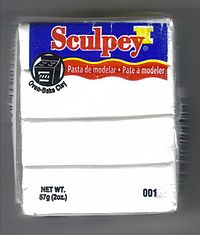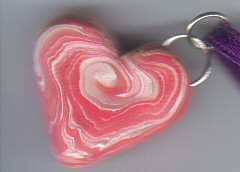
Sculpey
Encyclopedia

Polymer clay
Polymer clay is a sculptable material based on the polymer polyvinyl chloride . It usually contains no clay minerals, and is only called "clay" because its texture and working properties resemble those of mineral clay...
that can be molded and put into a conventional oven to harden, as opposed to typical modeling clays, which require a much hotter oven, such as a kiln
Kiln
A kiln is a thermally insulated chamber, or oven, in which a controlled temperature regime is produced. Uses include the hardening, burning or drying of materials...
. Until it is baked, Sculpey has a consistency somewhat like Plasticine
Plasticine
Plasticine, a brand of modelling clay, is a putty-like modelling material made from calcium salts, petroleum jelly and aliphatic acids. The name is a registered trademark of Flair Leisure Products plc...
. It is sold in many colors, though it can also be painted once fired. It has become popular with modeling artists. It is also sometimes used for claymation.
Sculpey is a brand of polymer clay made by Polyform Products in the United States. Sculpey was first created in the early 1960’s. The original idea was to use the clay as a thermal transfer compound; this would conduct heat away from the cores of electrical transformers. However, the compound was not successful for this use so it was pushed to the side for awhile. In the late 1960’s it was then discovered that this compound could be molded, baked, sanded, drilled, carved and painted. This was a perfect medium for the craft industry. The clay was marketed directly to people at craft shows, street fairs and demonstrations in small art stores.
Sculpey closely resembles Fimo
FIMO
Fimo is a name for a brand of polymer clay made by German company Staedtler . Fimo is sold worldwide. Its main U.S. competitor is the American brand Sculpey. The material comes in many different colors; there are many finishes to choose from, and even a softener to use with it because it can be...
, another brand of polymer clay. Sculpey is a less rigid composition which better suits modeling, while Fimo is better suited for twisting into cane and bead making because the colors do not blend together as readily. The plasticity is controlled by the amount of oil suspending the polymers in the "clay".

Sculpture
Sculpture is one of many techniques used for working with polymer clay. It involves creating detailed representations of objects.Caning
This technique was borrowed from glass artisans, who would know it as millefioriMillefiori
Millefiori is a glasswork technique which produces distinctive decorative patterns on glassware.The term millefiori is a combination of the Italian words "mille" and "fiori" . Apsley Pellatt was the first to use the term "millefiori", which appeared in the Oxford Dictionary in 1849...
, meaning "a thousand flowers". It involves making a picture from thick pieces of polymer clay, which is then extruded so the picture becomes smaller and it becomes thicker, until it is longer than it is high. The cane has the original picture running right through it, although smaller. It can then be sliced, with the slices used to cover other objects or blobs of scrap polymer clay.
Marbling
Marbling is one of the simplest techniques used with polymer clay. It involves mixing different colors of polymer clay together to form a pattern. As the clay is mixed, the pattern becomes smaller and smaller, until the two colors are completely blended.Mokume-Gane
Mokume-GaneMokume-gane
is a mixed-metal laminate with distinctive layered patterns. Translating as burl metal, the name was borrowed from one type of pattern created in the forging of swords and other edged weapons.- History :...
is a technique borrowed from metalworking. It involves placing several sheets of clay on top of each other and then pushing an object through it.
Types
Sculpey is usually available in 2 oz squares, but can be purchased in 1 pound blocks. There are a variety of clays available.Classic
There are several types of Sculpey available, Sculpey III, Premo!, Super Sculpey and Original Sculpey. The clay is available in a wide range of colors including 'Pearl' which shines after glazing. The clay is soft and pliable from the packaging and does not dry out. The clays harden after baking.Translucent
As the name implies, this clay becomes partially transparent when baked. Colors can be added to it, creating effects such as that in this picture.
Stone effect
Granitex contains tiny fibers which create a stone effect. It is not suitable for 'caning' (see above) as the particles cause the image to become blurred and low quality.Flexible clay
The Amazing Eraser Clay functions as an eraser after it is baked. The array of colours available from this range is limited when compared to that of the classic range. This clay is generally sold in packs of five differently coloured half-blocks.Sculpey also offers a super flexible clay called Bake & Bend which acts like rubber after baking.

